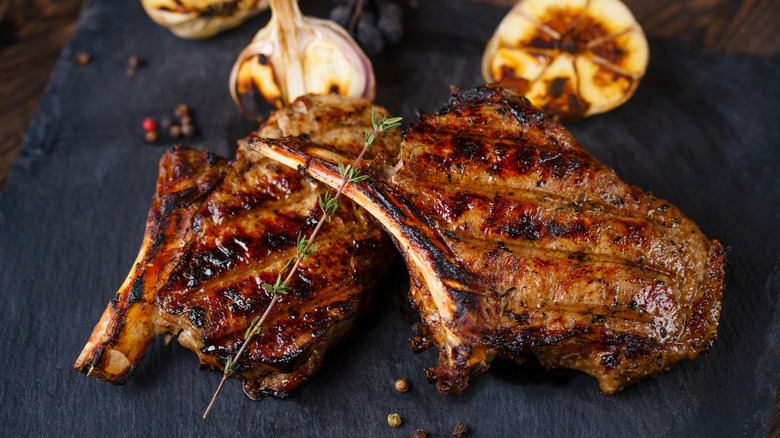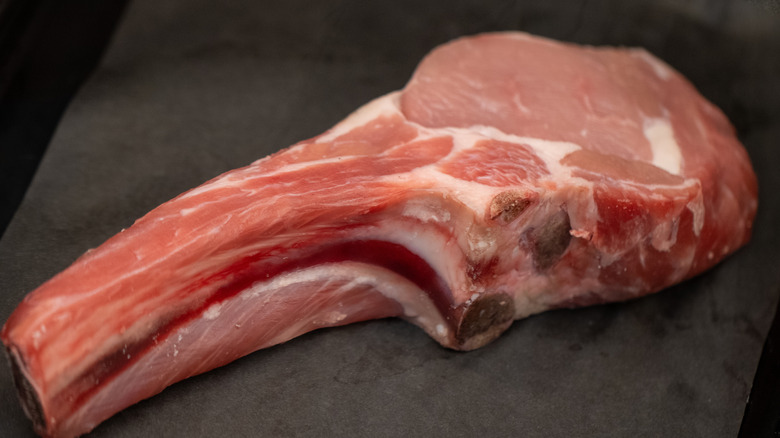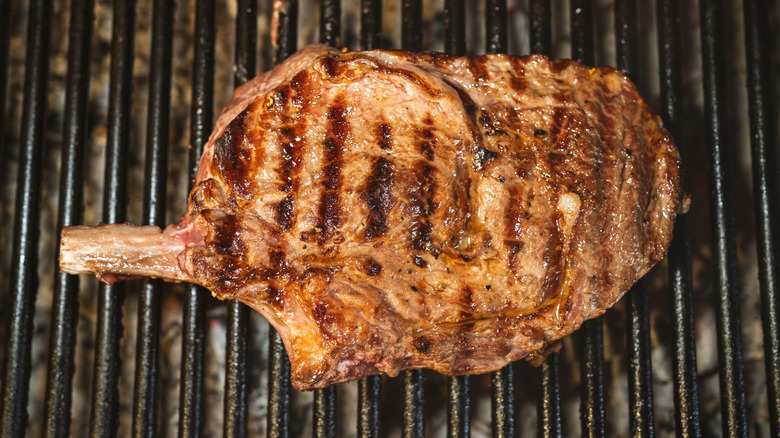What Sets Cowboy Steak Apart From Other Cuts?
There are many standard cuts of beef at the grocery store or butcher shop. While some are distinct, defined by the specific muscle being processed, others represent variations on a theme. For example, filet mignon is a cut from the tenderloin, and both it and the New York strip are part of the larger T-bone cut. But even more subtle differences define two popular steak cuts: The tomahawk and cowboy. Learning the difference between the two will help in appreciating why they even exist as distinctly named cuts.
If you haven't heard of the cowboy steak, perhaps it's because you aren't frequenting the upscale steakhouses where it's commonly served. Or you may be more familiar with the cowboy steak's sibling the tomahawk, or its parent the ribeye. All three are basically the same cuts of meat, with different treatments to the bone. All three are excellent options for grilling, due to their size and marbled fat content. In fact, the ribeye is considered by many as the perfect cut for grilling. So it stands to reason, once you understand how its processed, that the cowboy cut is also delicious grilled. While both the tomahawk and cowboy cuts have been around a long time, it seems as if each has received renewed attention in steakhouses and from home grilling enthusiasts over the past few years.
The technique that defines a cowboy steak
When breaking down a steer or cow (or any animal), the butcher has several choices with each cut. Keep the bone in or remove it? Break it down into smaller cuts? Butterfly or fillet it? Trim the fat? In the case of the ribeye, a massive cut that sits along the animal's front (or primal) ribs. It's an area that doesn't receive a lot of exercise in grazing animals, so there's plenty of fat marbled throughout. The cut is also attached to a large rib bone. If the butcher removes the bone, it's a classic ribeye.
If the bone is left in, as is, it may be called a bone-in ribeye or a rib steak. However, if the bone is Frenched – that is, partially cleaned, with all tissue (meat, fat, and cartilage) along the end of the bone removed — it becomes either a tomahawk or cowboy cut. Both feature exposed bone, but the length of the exposed bone is what differentiates the two.
Tomahawk vs. cowboy cut steaks
A tomahawk cut — popular in upscale restaurants for its size and dramatic appearance — features a long, exposed bone. In fact, the name stems from the look of the cut, like a long-handled axe or tomahawk. In general, the exposed, Frenched rib, will be at least five inches long, but could be longer, while the meat is generally at least two inches thick. The tomahawk is considered one of those cuts of steak you should always buy (if you can afford it). It's a full-flavored steak, with a hint of sweetness, that also dry-ages well.
The cowboy steak (or cowboy ribeye) is the same cut and technique, but most of the exposed bone is cut off. This makes it easier to handle (and to fit in a large pan), and gives it something closer to a traditional steak look, rather than looking something like an oversized pork chop. While some sources suggest it was a relatively crude cut originating in cowboy culture, others believe the name may simply reflect the steak's somewhat rugged vibe. When grilling, consider searing on high heat first to get a nice crust, then moving it to a lower temperature zone to fully cook. As with the tomahawk, it's high-fat juiciness is something of a steakhouse secret. While some people might claim they can perceive a taste difference between these two Frenched, bone-in ribeyes, they're the same cut, so it's likely you won't notice a taste or texture difference.


